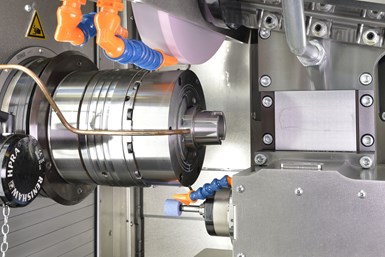The Advantages of Turning and Grinding on One Machine Platform
Instead of using a dedicated grinding machine or an outside grinding vendor to achieve very high surface finishes, a machine that can hard turn and grind can reduce WIP and speed part completion while taking up minimal floor space.
#techbrief

The external, water-cooled grinding spindle shown at the top is oriented at a fixed 12 degrees to the workpiece spindle to enable angular, in-feed grinding and end-face machining with peripheral grinding. Photo Credits: Spinner USA
The term “multitasking” when describing machining equipment can mean different things to different people and even different machine tool manufacturers.
When it comes to Spinner USA’s Microturn Grind, it means soft turning, hard turning, milling, drilling and internal and external grinding on one machine platform. Among other advantages, the company says this saves floor space and eliminates the cost of a dedicated grinding machine(s) as well as minimizes work in process (WIP) because parts can be machined complete.
Featured Content
The Microturn Grind’s 12-station turret with Y axis can access both spindles to perform soft or hard turning as well as milling and drilling. The turret’s BMT45 tool interface is said to provide high stiffness and all the 12 turret positions are driven tool stations to create features such as keyways and contoured features. Hard turning of workpieces to 60 HRC performed on the same machine minimizes the amount of stock to be removed by grinding or, in some applications, can eliminate grinding altogether.
Both main and subspindles are identical and offer speeds as high as 10,000 rpm. (The machine is also available with only a main spindle.) Touch probes can be mounted in the turret to enable in-machine measurement of internal and external workpiece features for automatic process control, tooling offset adjustments and determining workpiece position prior to machining.

The Microturn Grind features two stations with internal grinding spindles programmable to 90,000 rpm. These stations can be configured such that one faces the main spindle and the other the subspindle, or both can face the same spindle depending on a shop’s needs.
The external, water-cooled grinding spindle is oriented at a fixed 12 degrees to the workpiece spindle to enable angular, in-feed grinding and end-face machining with peripheral grinding. Having a maximum wheel diameter of 400 mm, it is said to provide the capability to provide material removal rates and wheel life of dedicated cylindrical grinding machines achieving speeds as high as 4,000 rpm. C-axis interpolation enables the machine to grind non-round polygonal shapes at creep speed.
The Microturn Grind features two stations with internal grinding spindles programmable to 90,000 rpm. These stations can be configured such that one faces the main spindle and the other the subspindle, or both can face the same spindle depending on a shop’s needs. Diamond dressing units for the internal and external grinding wheels are mounted on the main and subspindle housings.
To enable unattended machining, a number of automation options are available, including bar feeders, pallet changers and custom automation solutions through Spinner-Automation GmbH.
RELATED CONTENT
-
Making Parts on a Swiss/Laser Machine
Adding laser cutting to Swiss-type machining is helping this shop do more work for its customers in the medical industry.
-
How to Get More Efficient Production from Swiss-Type and Multitasking Machines
SolidCAM for multi-axis Swiss type and multitasking machines provides a very efficient CAM programming process, generating optimal and safe Mill-Turn programs, with dramatically improved milling tool life.
-
Dry Swiss Machining in Medical
Continuing to build its reputation for creative solutions, this multi-faceted medical device component manufacturer took its Swiss machining operations to a new level to meet a customer’s market demands.








